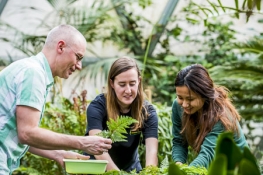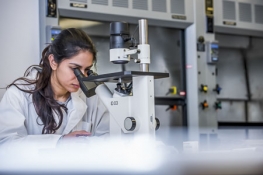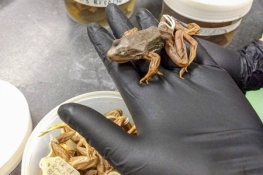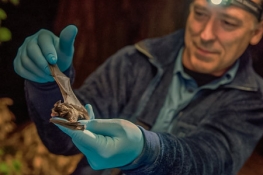Oscar Vargas Ph.D.
Assistant Professor - Botany
Oscar grew up in Colombia where he obtained his BSc and MSc at the Universidad de los Andes, he moved to the US to pursue a PhD in Plant Biology at The University of Texas at Austin. After graduating from his PhD in 2016 Oscar was a postdoctoral fellow at the University of Michigan and the University of California, Santa Cruz; he joined Humboldt in 2020.
Specialty Area
Plant phylogenetics and speciation; diversification in the Californian Floristic Province and the Neotropics
Education
Courses Taught
Research
Our lab is dedicated to document plant diversity and evolution. We combine elements of traditional botany (alpha taxonomy and morphometrics) with modern tools (next generation sequencing and comparative methods) to answer questions about the evolution of biodiversity hot-spots from the Amazon to the Californian Floristic Province (CFP).
Publications
- Larson D, Vargas OM, Vicentini A, Dick CW. 2021. Admixture may be extensive among hyperdominant Amazon rainforest tree species. New Phytologist. https://doi.org/10.1111/nph.17675
- Díaz-Vasco O., Baca-Gamboa AE, Calderón-Arias AM, Ramírez-Padilla BR, Idárraga-P Á, Pizano-Gómez C, Castellanos-Castro C, Castro C, Mendoza H, Posada JM, Vargas OM, Vieira-Uribe S, Velásquez-Hurtado A, Salinas NR, García N. 2021. Lista Roja de Plantas Vasculares Endémicas de la Alta Montaña de Colombia. Instituto de Investigación de Recursos Biológicos Alexander von Humboldt, Unión Europea., Bogota, Colombia. http://hdl.handle.net/20.500.11761/35749
- Vargas OM, Goldston B, Grossenbacher DL, Kay MK. 2020. Patterns of speciation are similar across mountainous and lowland regions for a Neotropical plant radiation (Costaceae: Costus). Evolution 74: 2644–2661. https://doi.org/10.1111/evo.14108
- Larson DA, Walker JF, Vargas OM, Smith SA. 2020. A consensus phylogenomic approach highlights paleopolyploid and rapid radiation in the history of Ericales. American Journal of Botany 107:1–17. https://doi.org/10.1002/ajb2.1469
- Baker PA, Fritz SC, Dick CW, Prates I, Battisti DS, Vargas OM, Asner GP, Martin RE, Wheatley A. 2020. Beyond Refugia: New insights on Quaternary climate variation and the evolution of biotic diversity in tropical South America, in Rull V & Carnaval A (Eds.) Neotropical Diversification: Patterns and Processes. Springer, 51–70. https://doi.org/10.1007/978-3-030-31167-4_3
- Vargas OM, Dick CW. 2020. Diversification history of Neotropical Lecythidaceae, an ecologically dominant tree family of Amazon rain forest, in Rull V & Carnaval A (Eds.) Neotropical Diversification: Patterns and Processes. Springer, 791–809. https://doi.org/10.1007/978-3-030-31167-4_29
- Saldivia P, Vargas OM, Orlovich DA, Lord JM. 2019. Nomenclatural priority of the genus Linochilus over Piofontia (Asteraceae: Astereae). Phytotaxa 424 (3): 158-166. http://dx.doi.org/10.11646/phytotaxa.424.3.3
- Walker JW, Walker-Hale N, Vargas OM, Larson DA, Stull GW. 2019. Characterizing gene tree conflict in plastome-inferred phylogenies. PeerJ 7: e7747 https://doi.org/10.7717/peerj.7747
- Vargas OM, Heuertz M, Smith SA, Dick CW. 2019. Target sequence capture in the Brazil nut family (Lecythidaceae): marker selection and in silico capture from genome skimming data. Molecular Phylogenetics and Evolution 135: 98–104 https://doi.org/10.1016/j.ympev.2019.02.020
- Thomson AM*, Vargas OM*, Dick CW. 2018. Complete plastome sequences from Bertholletia excelsa and 23 related species yield informative markers for Lecythidaceae. Applications in Plant Sciences 6: e1151. https://doi.org/10.1002/aps3.1151
- Vargas OM. 2018. Reinstatement of the genus Piofontia: a phylogenomic-based study reveals the biphyletic nature of Diplostephium (Asteraceae: Astereae). Systematic Botany 43: 485–496. http://dx.doi.org/10.1600/036364418X697210
- Brown JW, Parins-Fukuchi C, Stull GW, Vargas OM, Smith SA. 2017. Bayesian and likelihood phylogenetic reconstructions of morphological traits are not discordant when taking uncertainty into consideration. A comment on Puttick et al. Proceedings of the Royal Society B 284: 20170986. http://dx.doi.org/10.1098/rspb.2017.0986
- Vargas OM, Ortiz EM, Simpson BB. 2017. Conflicting phylogenomic signals reveal a pattern of reticulate evolution in a recent high-Andean diversification (Asteraceae: Astereae: Diplostephium). New Phytologist 214:1736–1750. https://doi.org/10.1111/nph.14530
- Avila F, Funk VA, Diazgranados M, Díaz-Piedrahíta S, Vargas OM. 2016. Asteraceae. in: Bernal R, Gradstein SR, Celis M, eds. Catálago de líquenes y plantas de Colombia v. 1. Bogotá, Colombia: Editorial Universidad Nacional de Colombia, 795–908.
- Vargas OM, Madriñán S. 2012. Preliminary Phylogeny of Diplostephium (Asteraceae): Speciation Rate and Character Evolution. Lundellia 15: 1–15.
- Vargas OM. 2011. A nomenclator of Diplostephium (Asteraceae: Astereae): a list of species with their synonyms and distributions by country. Lundellia 14: 32–51.
- Vargas OM, Madriñán S. 2006. Clave para la indentificación de las especies de Diplostephium (Asteraceae, Astereae) en Colombia. Revista de la Academia Colombiana de Ciencias Exactas Físicas y Naturales 30(117): 489-494.












